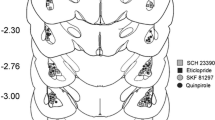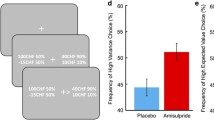Abstract
Rationale
Laboratory experiments often model risk through a choice between a large, uncertain (LU) reward against a small, certain (SC) reward as an index of an individual’s risk tolerance. An important factor generally lacking from these procedures are reward-associated cues that may modulate risk preferences.
Objective
We tested whether the addition of cues signaling ‘jackpot’ wins to LU choices would modulate risk preferences and if these cue effects were mediated by dopaminergic signaling.
Methods
Three groups of rats chose between LU and SC rewards for which the LU probability of reward decreased across blocks. The unsignaled group received a non-informative stimulus of trial outcome. The signaled group received a jackpot signal prior to reward delivery and blackout on losses. The signaled-light group received a similar jackpot for wins, but a salient loss signal distinct from the win signal.
Results
Presenting win signals decreased the discounting of LU value for both signaled groups regardless of loss signal, while the unsignaled group showed discounting similar to previous research without cues. Pharmacological challenges with D1/D2 agonists and antagonists revealed that D1 antagonism increased and decreased sensitives to the relative probability of reward for unsignaled and signaled groups, respectively, while D2 agonists decreased sensitivities to the relative magnitude of reward.
Conclusion
The results highlight how signals predictive of wins can promote maladaptive risk taking in individuals, while loss signals have reduced effect. Additionally, the presence of reward-predictive cues may change the underlying neurobehavioral mechanisms mediating decision-making under risk.







Similar content being viewed by others
References
Anselme P (2015) Incentive salience attribution under reward uncertainty: a Pavlovian model. Behav Process 111:6–18
Anselme P, Robinson MJF, Berridge KC (2013) Reward uncertainty enhances incentive salience attribution as sign-tracking. Behav Brain Res 238:53–61. https://doi.org/10.1016/j.bbr.2012.10.006
Barrus MM, Winstanley CA (2016) Dopamine D3 receptors modulate the ability of win-paired cues to increase risky choice in a rat gambling task. J Neurosci 36:785–794
Barrus MM, Cherkasova M, Winstanley CA (2015) Skewed by cues? The motivational role of audiovisual stimuli in modelling substance use and gambling disorders. In: Behavioral neuroscience of motivation. Springer, pp 507–529
Beckmann JS, Chow JJ (2015) Isolating the incentive salience of reward-associated stimuli: value, choice, and persistence. Learn Mem 22:116–127
Cardinal RN, Howes NJ (2005) Effects of lesions of the nucleus accumbens core on choice between small certain rewards and large uncertain rewards in rats. BMC Neurosci 6:37
Chow JJ, Smith AP, Wilson AG, Zentall TR, Beckmann JS (2017) Suboptimal choice in rats: incentive salience attribution promotes maladaptive decision-making. Behav Brain Res 320:244–254. https://doi.org/10.1016/j.bbr.2016.12.013
Clark CA, Dagher A (2014) The role of dopamine in risk taking: a specific look at Parkinson’s disease and gambling. Front Behav Neurosci 8:196. https://doi.org/10.3389/fnbeh.2014.00196
Cooper S, Al-Naser H (2006) Dopaminergic control of food choice: contrasting effects of SKF 38393 and quinpirole on high-palatability food preference in the rat. Neuropharmacology 50:953–963
Fiorillo CD, Tobler PN, Schultz W (2003) Discrete coding of reward probability and uncertainty by dopamine neurons. Science 299:1898–1902. https://doi.org/10.1126/science.1077349
Flagel SB et al (2011) A selective role for dopamine in reward learning. Nature 469:53–57. https://doi.org/10.1038/nature09588
Fortes I, Vasconcelos M, Machado A (2016) Testing the boundaries of “paradoxical” predictions: pigeons do disregard bad news. J Exp Psychol Anim learn cogn 42(4):336–346
Glimcher PW (2011) Understanding dopamine and reinforcement learning: the dopamine reward prediction error hypothesis. Proc Natl Acad Sci U S Am 108:15647–15654
Herrnstein RJ (1990) Rational choice theory: necessary but not sufficient. Am Psychol 45:356–367. https://doi.org/10.1037/0003-066X.45.3.356
Hochberg Y (1988) A sharper Bonferroni procedure for multiple tests of significance. Biometrika 75:800–802
Holt DD, Green L, Myerson J (2003) Is discounting impulsive?: Evidence from temporal and probability discounting in gambling and non-gambling college students. Behav Process 64:355–367
Hothorn T, Bretz F, Westfall P (2008) Simultaneous inference in general parametric models. Biom J 50:346–363
Kahneman D (2003) A perspective on judgment and choice: mapping bounded rationality. Am Psychol 58:697
Kahneman D, Tversky A (1979) Prospect theory: an analysis of decision under risk. Econometrica 47:263–291. https://doi.org/10.2307/1914185
Koffarnus MN, Newman AH, Grundt P, Rice KC, Woods JH (2011) Effects of selective dopaminergic compounds on a delay discounting task. Behav Pharmacol 22:300
Laude JR, Stagner JP, Zentall TR (2014) Suboptimal choice by pigeons may result from the diminishing effect of nonreinforcement. J Exp Psychol: Anim Learn Cogn 40:12–21
Levant B, De Souza EB (1993) Differential pharmacological profile of striatal and cerebellar dopamine receptors labeled by [3H] quinpirole: identification of a discrete population of putative D3 receptors. Synapse 14:90–95
Lin X, Zhou H, Dong G, Du X (2015) Impaired risk evaluation in people with Internet gaming disorder: fMRI evidence from a probability discounting task. Prog Neuro-Psychopharmacol Biol Psychiatry 56:142–148. https://doi.org/10.1016/j.pnpbp.2014.08.016
Madden GJ, Petry NM, Johnson PS (2009) Pathological gamblers discount probabilistic rewards less steeply than matched controls. Exp Clin Psychopharmacol 17:283
Marshall AT, Kirkpatrick K (2017) Reinforcement learning models of risky choice and the promotion of risk-taking by losses disguised as wins in rats. J Exp Psychol: Anim Learn Cogn 43:262
Martínez M, Alba R, Rodríguez W, Orduña V (2017) Incentive salience attribution is not the sole determinant of suboptimal choice in rats: conditioned inhibition matters. Behavioural Processes 142:99–105
McDevitt MA, Dunn RM, Spetch ML, Ludvig EA (2016) When good news leads to bad choices. J Exp Anal Behav 105:23–40. https://doi.org/10.1002/jeab.192
Molet M, Miller H, Laude J, Kirk C, Manning B, Zentall T (2012) Decision making by humans in a behavioral task: do humans, like pigeons, show suboptimal choice? Learn Behav 40:439–447. https://doi.org/10.3758/s13420-012-0065-7
Onge JRS, Ahn S, Phillips AG, Floresco SB (2012) Dynamic fluctuations in dopamine efflux in the prefrontal cortex and nucleus accumbens during risk-based decision making. J Neurosci 32:16880–16891
Orsini CA, Moorman DE, Young JW, Setlow B, Floresco SB (2015) Neural mechanisms regulating different forms of risk-related decision-making: insights from animal models. Neurosci Biobehav Rev 58:147–167. https://doi.org/10.1016/j.neubiorev.2015.04.009
Petry NM (2012) Discounting of probabilistic rewards is associated with gambling abstinence in treatment-seeking pathological gamblers. J Abnorm Psychol 121:151–159. https://doi.org/10.1037/a0024782
Picker M, Poling A (1982) Choice as a dependent measure in autoshaping: sensitivity to frequency and duration of food presentation. J Exp Anal Behav 37:393–406. https://doi.org/10.1901/jeab.1982.37-393
Pinheiro J, Bates D, DebRoy S, Team RC (2016) nlme: linear and nonlinear mixed effects models R package version 31-128
Pisklak JM, McDevitt MA, Dunn RM, Spetch ML (2015) When good pigeons make bad decisions: choice with probabilistic delays and outcomes. J Exp Anal Behav 104:241–251. https://doi.org/10.1002/jeab.177
Rachlin H, Raineri A, Cross D (1991) Subjective probability and delay. J Exp Anal Behav 55:233–244. https://doi.org/10.1901/jeab.1991.55-233
Rasmussen EB, Lawyer SR, Reilly W (2010) Percent body fat is related to delay and probability discounting for food in humans. Behav Processes 83:23–30. https://doi.org/10.1016/j.beproc.2009.09.001
Reynolds B, Richards JB, Horn K, Karraker K (2004) Delay discounting and probability discounting as related to cigarette smoking status in adults. Behav Processes 65:35–42
Robinson TE, Berridge KC (2008) Review. The incentive sensitization theory of addiction: some current issues. Philos Trans R Soc Lond B Biol Sci 363:3137–3146. https://doi.org/10.1098/rstb.2008.0093
Schultz W (2010) Dopamine signals for reward value and risk: basic and recent data. Behav Brain Funct 6:24
Smith AP, Zentall TR (2016) Suboptimal choice in pigeons: choice is primarily based on the value of the conditioned reinforcer rather than overall reinforcement rate. J Exp Psychol: Anim Learn Cogn 42:212–220. https://doi.org/10.1037/xan0000092
Smith AP, Bailey AR, Chow JJ, Beckmann JS, Zentall TR (2016) Suboptimal choice in pigeons: stimulus value predicts choice over frequencies. PloS One 11(7):e0159336
Smith AP, Beckmann JS, Zentall TR (2017) Gambling-like behavior in pigeons: ‘jackpot’ signals promote maladaptive risky choice Sci Rep
St Onge JR, Floresco SB (2009) Dopaminergic modulation of risk-based decision making. Neuropsychopharmacology 34:681–697 http://www.nature.com/npp/journal/v34/n3/suppinfo/npp2008121s1.html
Stephens DW, Krebs JR (1986) Foraging theory. Princeton University Press
Stopper CM, Khayambashi S, Floresco SB (2013) Receptor-specific modulation of risk-based decision making by nucleus accumbens dopamine. Neuropsychopharmacology 38:715–728
Sugam JA, Day JJ, Wightman RM, Carelli RM (2012) Phasic nucleus accumbens dopamine encodes risk-based decision-making behavior. Biol Psychiatry 71:199–205
Trujano RE, Orduna V (2015) Rats are optimal in a choice task in which pigeons are not. Behav Processes 119:22–27
Trujano RE, López P, Rojas-Leguizamón M, Orduña V (2016) Optimal behavior by rats in a choice task is associated to a persistent conditioned inhibition effect. Behav Processes 130:65–70
van Holst RJ, van den Brink W, Veltman DJ, Goudriaan AE (2010) Why gamblers fail to win: a review of cognitive and neuroimaging findings in pathological gambling. Neurosci Biobehav Rev 34:87–107
Vasconcelos M, Monteiro T, Kacelnik A (2015) Irrational choice and the value of information. Sci Rep 5:13874. https://doi.org/10.1038/srep13874
Wagenmakers E-J, Farrell S (2004) AIC model selection using Akaike weights. Psychon Bull Rev 11:192–196
Yates JR, Breitenstein KA, Gunkel BT, Hughes MN, Johnson AB, Rogers KK, Shape SM (2016) Effects of NMDA receptor antagonists on probability discounting depend on the order of probability presentation. Pharmacol Biochem Behav 150–151:31–38. https://doi.org/10.1016/j.pbb.2016.09.004
Young ME (2017) Discounting: a practical guide to multilevel analysis of indifference data. J Exp Anal Behav 108(1):97–112
Young ME, Clark M, Goffus A, Hoane MR (2009) Mixed effects modeling of Morris water maze data: advantages and cautionary notes. Learn Motiv 40:160–177
Zentall TR (2016) Resolving the paradox of suboptimal choice. J Exp Psychol: Anim Learn Cogn 42:1
Zentall TR, Laude JR, Stagner JP, Smith AP (2015) Suboptimal choice by pigeons: evidence that the value of the conditioned reinforcer rather than its frequency determines choice. Psychol Rec 65:223–229
Acknowledgements
We thank Josh Lavy for his technical assistance.
Funding
This work was supported by the National Institute of Drug Abuse, DA033373 and DA016176.
Author information
Authors and Affiliations
Corresponding author
Electronic supplementary material
ESM 1
(DOCX 356 kb)
Rights and permissions
About this article
Cite this article
Smith, A.P., Hofford, R.S., Zentall, T.R. et al. The role of ‘jackpot’ stimuli in maladaptive decision-making: dissociable effects of D1/D2 receptor agonists and antagonists. Psychopharmacology 235, 1427–1437 (2018). https://doi.org/10.1007/s00213-018-4851-6
Received:
Accepted:
Published:
Issue Date:
DOI: https://doi.org/10.1007/s00213-018-4851-6




